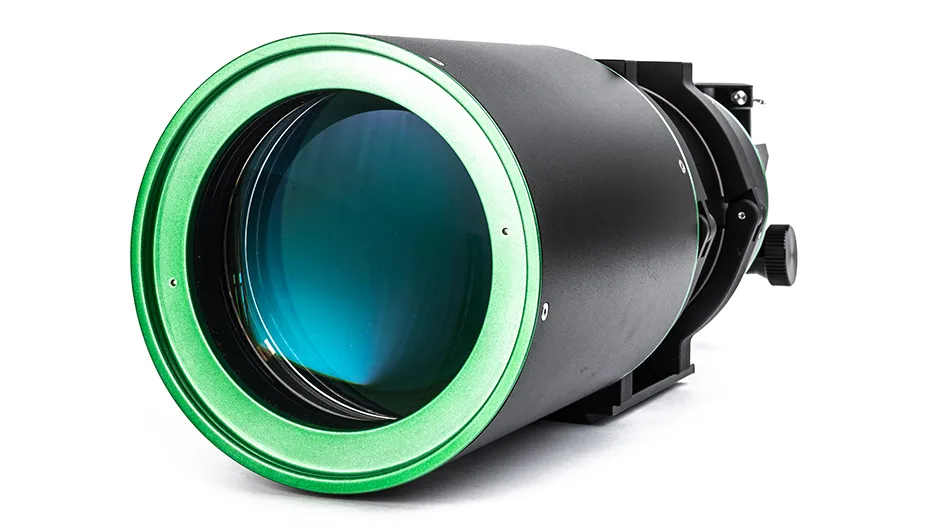Price: £2155.00
Aperture: 150mm (6 inches)
Focal Length: 750mm (f/5)
Weight: 15kg
Supplier: Peak2Valley Instruments
Telephone: 01298 732440
Website: www.peak2valleyinstruments.co.uk
There have been all kinds of refracting telescopes ever since Galileo turned his crude version to the heavens.
One thing that quickly became evident was that lenses exhibit various defects, including chromatic aberration, astigmatism and spherical aberration.
Modern scopes often employ a triplet of lenses to compensate for such errors, but iStar has taken a slightly different approach with the Asteria WFX 150-5 R50 anastigmat refractor.
The instruments in the ‘Rx’ series are tuned slightly towards red wavelengths, where the eye is less sensitive.
The 6-inch primary lens arrangement has a short focal length of 750mm, making this a fast, f/5 system.

The tube itself is manufactured from aircraft-grade magnesium alloy, which is strong and rigid but quite heavy.
However, we found our NEQ6 mount with two 5kg counterweights handled it very well.
The telescope tube comes with a retractable dew shield and CNC-machined tube rings.
There is also a choice of mounting plate between Vixen or Losmandy – the latter is preferred for the extra stability it gives when attached to the mount.
The Asteria can be ordered with one of two focusers: the standard model is a Moonlite 2-inch dual-speed focuser, or you can upgrade to a Starlight Feathertouch focuser.
The latter was supplied for this review.

We were loaned the use of the iStar Professional 2-inch dielectric diagonal, again available at extra cost, and found it worked very well with the system.
For testing we used our own 26mm and 10mm eyepieces, and 2x and 3x Barlow lenses for added magnification.
Travels in the sky
To achieve balance, we found we had to extend the dew shield fully and then carefully move the telescope tube until the front tube ring just touched the rear of the dew shield.
After this we found balancing the system even with our Canon EOS 50D DSLR attached quite straightforward.
With the 26mm eyepiece in place we noted a little colour fringing around the brightest stars, but overall the field of view was sharp almost to the edge.

Fainter stars showed little or no colour fringing until we cranked up the magnification with the 10mm and 2x Barlow lens, but bear in mind this system is intended mainly for wide-field views and in that respect it certainly did a good job.
The 26mm eyepiece allowed us to fit the Sword of Orion into the view, from the star cluster NGC 1981 past the Orion Nebula to just beyond Iota Orionis.
This gave almost a 2º field of view, ideal for many large subjects such as M45, the Pleiades open cluster in Taurus.
While aimed at the Sword we also enjoyed the wreaths of nebulosity visible in the central Orion Nebula, and with averted vision could just see a hint of the Running Man Nebula to the north of it.
The stars of the Pleiades were a resplendent sight, with a hint of the Merope nebulosity hanging away from its namesake star.
The Andromeda Galaxy stretched from across the view, its two companions visible along with signs of the dust lanes.
We removed the diagonal and attached a DSLR with an adaptor of our own.

We took 43 images of the Sword of Orion, each 90 seconds duration at ISO 1600, and stacked them.
Although there were some signs of the colour fringing in the resulting image, especially towards the edges, it was acceptable and showed plenty of detail in the nebulosity.
Adding narrowband filters would reduce the impact of colour fringing and make the Asteria WFX a great wide-field imaging system.
Impressive flatness
The Asteria WFX has quite a flat field for such a short focal length instrument.
Fast optical systems (ie those with short focal ratios) can suffer from distortion at the edges of the view.
The usual solution is to add a flat-field corrector, however this instrument impressed us with its pinpoint stars almost to the field edge, both visually with our 26mm eyepiece and photographically too.

According to iStar, the ‘R50’ in the optics specs indicates that in bench tests this scope produces a spot size that is 50 per cent smaller than more usual doublet designs, though it will not divulge what glass type is used.
We did notice some chromatic aberration creeping in at the edges of our images of the Sword of Orion, but otherwise they held a lot of detail.
Mounting
The Asteria WFX is equipped with CNC-machined tube rings that were easy to adjust with the thumbscrews.
They can be supplied with either a Vixen or Losmandy mounting plate – the Losmandy being more stable.
Focuser
The Starlight Feathertouch dual-speed focuser has a generous 90mm of focus travel and can be rotated and tightened via three brass locking screws, allowing for better framing of a camera.
A locking bolt underneath fixes the focus position.

Body
The tube is constructed from aircraft-grade magnesium alloy and keeps the optics held firm.
The inside of the tube is matt black and baffled to prevent stray light bouncing around inside.
Optics
The optical arrangement is an anastagmatic semi apo doublet objective, which is fully multicoated.
Being f/5 makes this a ‘fast’ system, giving a wide field of view ideal for large subjects such as the Andromeda Galaxy or the Sword of Orion.
Dew shield
The retractable dew shield was a little tight but smooth to use, though the tightness did help to keep it fully extended when in use.
It gave good protection from dewing up under damp conditions and the lens cap is held in place on the green, anodised metal lip with magnets.
This review originally appeared in the March 2016 issue of BBC Sky at Night Magazine.
